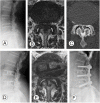Unplanned Second-Stage Decompression for Neurological Deterioration Caused by Central Canal Stenosis after Indirect Lumbar Decompression Surgery
- PMID: 30866617
- PMCID: PMC6680044
- DOI: 10.31616/asj.2018.0232
Unplanned Second-Stage Decompression for Neurological Deterioration Caused by Central Canal Stenosis after Indirect Lumbar Decompression Surgery
Abstract
Study design: Prospective cohort study.
Purpose: This study aimed to identify risk factors for unplanned second-stage decompression for postoperative neurological deficit after indirect decompression using lateral lumbar interbody fusion (LLIF) with posterior fixation.
Overview of literature: Indirect lumbar decompression with LLIF has been used as a minimally invasive alternative to direct decompression to treat degenerative lumbar diseases requiring neural decompression. However, evidence on the prevalence of neurological deficits caused by spinal canal stenosis after indirect decompression is limited.
Methods: This study included 158 patients (mean age, 71.13±7.98 years; male/female ratio, 67/91) who underwent indirect decompression with LLIF and posterior fixation. Indirect decompression was performed at 271 levels (mean level, 1.71±0.97). Logistic regression analysis was used to identify the risk factors for postoperative neurological deficits. The variables included were age, sex, body mass index, presence of primary diseases, diabetes mellitus, preoperative motor deficit, levels operated on, preoperative severity of lumbar stenosis, and preoperative Japanese Orthopedic Association (JOA) score.
Results: Postoperative neurological deficit due to spinal canal stenosis occurred in three patients (1.9%). Spinal stenosis due to hemodialysis (p<0.001), ligament ossification (p<0.001), presence of preoperative motor paralysis (p<0.001), low JOA score (p=0.004), and severe canal stenosis (p=0.02) were significantly more frequent in the paralysis group.
Conclusions: Severe preoperative canal stenosis and neurological deficit were identified as risk factors for postoperative neurological deterioration caused by spinal canal stenosis. Additionally, uncommon diseases, such as spinal stenosis due to hemodialysis and ligament ossification, increased the risk of postoperative neurological deficit; therefore, in such cases, indirect decompression is contraindicated.
Keywords: Complication; Indirect decompression; Lateral interbody fusion; Lumbar stenosis; Neurological deterioration.
Conflict of interest statement
No potential conflict of interest relevant to this article was reported.
Figures


Similar articles
-
Indirect Decompression Using Lateral Lumbar Interbody Fusion for Restenosis after an Initial Decompression Surgery.Asian Spine J. 2020 Jun;14(3):305-311. doi: 10.31616/asj.2019.0194. Epub 2020 Jan 8. Asian Spine J. 2020. PMID: 31906613 Free PMC article.
-
Predictors of indirect neural decompression in minimally invasive transpsoas lateral lumbar interbody fusion.J Neurosurg Spine. 2021 Apr 30;35(1):80-90. doi: 10.3171/2020.8.SPINE20676. Print 2021 Jul 1. J Neurosurg Spine. 2021. PMID: 33930860
-
Comprehensive Assessment of Indirect Decompression Through Lateral Lumbar Interbody Fusion for Degenerative Lumbar Spinal Stenosis: A Japanese Orthopedic Association Back Pain Evaluation Questionnaire-Based Analysis.Global Spine J. 2025 Mar;15(2):656-667. doi: 10.1177/21925682231204254. Epub 2023 Sep 26. Global Spine J. 2025. PMID: 37750358 Free PMC article.
-
When Indirect Decompression Fails: A Review of 220 Consecutive Direct Lateral Interbody Fusions and Unplanned Secondary Decompression.Spine (Phila Pa 1976). 2021 Aug 15;46(16):1081-1086. doi: 10.1097/BRS.0000000000003976. Spine (Phila Pa 1976). 2021. PMID: 33534521 Review.
-
Is Indirect Decompression and Fusion More Effective than Direct Decompression and Fusion for Treating Degenerative Lumbar Spinal Stenosis With Instability? A Systematic Review and meta-Analysis.Global Spine J. 2023 Mar;13(2):499-511. doi: 10.1177/21925682221098362. Epub 2022 Apr 29. Global Spine J. 2023. PMID: 35486409 Free PMC article. Review.
Cited by
-
Instrumentation choice and early radiographic outcome following lateral lumbar interbody fusion (LLIF): Lateral instrumentation versus posterior pedicle screw fixation.N Am Spine Soc J. 2022 Oct 7;12:100176. doi: 10.1016/j.xnsj.2022.100176. eCollection 2022 Dec. N Am Spine Soc J. 2022. PMID: 36275075 Free PMC article.
-
Radiographic and clinical outcome of lateral lumbar interbody fusion for extreme lumbar spinal stenosis of Schizas grade D: a retrospective study.BMC Musculoskelet Disord. 2020 Apr 20;21(1):259. doi: 10.1186/s12891-020-03282-6. BMC Musculoskelet Disord. 2020. PMID: 32312254 Free PMC article.
-
Indirect Decompression for the Treatment of Degenerative Lumbar Stenosis.Int J Spine Surg. 2021 Dec;15(6):1066-1071. doi: 10.14444/8192. Int J Spine Surg. 2021. PMID: 35078878 Free PMC article.
-
Factors that influence the results of indirect decompression employing oblique lumbar interbody fusion.World J Orthop. 2024 Aug 18;15(8):734-743. doi: 10.5312/wjo.v15.i8.734. eCollection 2024 Aug 18. World J Orthop. 2024. PMID: 39165880 Free PMC article.
-
Indirect Decompression in Vertebral Reconstruction for Osteoporotic Vertebral Fractures with Neurological Symptoms: A Preliminary Case Series.Spine Surg Relat Res. 2024 May 10;8(6):623-630. doi: 10.22603/ssrr.2024-0013. eCollection 2024 Nov 27. Spine Surg Relat Res. 2024. PMID: 39659373 Free PMC article.
References
-
- Ozgur BM, Aryan HE, Pimenta L, Taylor WR. Extreme lateral interbody fusion (XLIF): a novel surgical technique for anterior lumbar interbody fusion. Spine J. 2006;6:435–43. - PubMed
-
- Oliveira L, Marchi L, Coutinho E, Pimenta L. A radiographic assessment of the ability of the extreme lateral interbody fusion procedure to indirectly decompress the neural elements. Spine (Phila Pa 1976) 2010;35:S331–7. - PubMed
-
- Fujibayashi S, Hynes RA, Otsuki B, Kimura H, Takemoto M, Matsuda S. Effect of indirect neural decompression through oblique lateral interbody fusion for degenerative lumbar disease. Spine (Phila Pa 1976) 2015;40:E175–82. - PubMed
LinkOut - more resources
Full Text Sources
Research Materials

